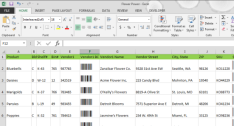
Barcodes: a new shorthand
Barcodes are everywhere. So much so that most of us see them without actually looking at them. They're on every item destined to be scanned at a cash register, on most US mail, on cartons and shipping boxes, your luggage at the airport, all UPS and FedEx packages, and the list goes on and on.
In spite of their prevalence, they're all but invisible to most people. When was the last time one caught your eye or sparked a conversation? Barcodes are so common that we don't notice them any more. In some ways this makes sense given that barcodes are made to be read by machines, not people.
But see them we do. In fact some see them for more than they really are, imbuing them with connotations far exceeding their intended use as auto ID glyphs. We often forget that they're just black and white patterns scanned by machines which translate them to 1's and 0's. No more, no less.
To some, barcodes are the Mark of the Beast, to others signs of creeping Big Brother-ism. Why? Because barcodes have entered the collective visual vocabulary. We may not focus on them but everyone knows what they are. No one really knows how they work but everyone recognizes them. Recognition without comprehension.
Barcodes have become contemporary visual memes. Immediately recognizable, they're glyphs, used by street artists and tattoo artists alike. Like corporate logos they "mean something". Different things to different people but they have weight.
Barcodes as visual images have seeped into mass media. For example, heavy metal band Slipknot is famous for their barcode tattoos and prison jump suits. Japanese pop star Namie Amuro has a barcode tattoo of her birthdate (19770920) on her wrist. Books are sold on their cover art and several have featured barcodes including "The Bar Code Tattoo" and "Bar Code Rebellion" both by author Suzanne Weyn, "Jennifer Government" by Max Berry, and "Culture Jam: The Uncooling of America" by Kalle Lasn. At least several of these incorporate barcodes into the narrative, forging a link between packaging and product. The TV show "Dark Angel" featured a character with a barcode tattooed on her neck. Before that "Aliens 3" (1992) featured inmates on a prison planet marked with barcode tattoos on their necks. Barcodes used to mark people are also found in the movies "Fortress" (1993) and "12 Monkeys" (1995). Humans as commodities to be tracked as inventory.
But in the real world barcodes are used to mark things, not people. This is the stated policy of GS1, the barcode standards body. Human beings are not inventory to be catalogued. Nevertheless a handful of people have voluntarily elected to implant RFID chips into their bodies.
Many fear creeping Big Brotherism, a fear that is often transposed into tattoos eerily reminiscent of the numbers on Nazi concentration camp prisoners. The rise of databases to track consumer data, travel records, and other personal information is a growing threat that shouldn't be minimized or trivialized. The appropriate response is to challenge those that collect and misuse such data, and to support fair and open usage policies. Reacting by making one's body a political billboard is ineffective at best.
These "I'm Fighting The Man" protests often use birthdays and social security numbers as the subject matter, a conclusion supported by admittedly unscientific anecdotal photographic evidence. Some dom/sub practitioners use barcode tattoos to codify their master/slave relationship. And of course the back of the neck is by far the most popular location for barcode ink.
Street artists, especially those doing stencils of a political/social nature, often use barcodes as glyphs and shorthand to denote the impact of dehumanization. Without a caption,, one is to assume the implied connotation of a barcode. Artist and viewer share an unspoken visual symbol, a cultural heiroglyph if you will. "You know this is a barcode and you know what that means..." This explains why so many t-shirts also use barcodes as visual elements.
Barcodes work as skin art and graffiti because they are a universally recognized symbol. We may not be able to read them but we all know what they mean. Neutral chunks of data to the machines that scan them but potent symbols and conclusions about contemporary life and the individual's relationship to technology for the rest of us. Barcodes, no caption needed.
In light of this, it's near impossible for anyone to "own" barcodes or their implementation. The various barcode specifications are global standards in the public domain. Software used to produce barcodes, as well as books about them, can be copyrighted. But UPC barcodes are made according to an international standard and don't involve licensing core intellectual property.
Attempts to "own" barcodes or their use based on securing patents is suspect. The specifications and guidelines that describe barcodes are in the public domain. It's not against the law to create one's own Code 128 or UPC barcode any more than it's illegal to use barcodes to make artwork. In fact, it isn't illegal to make a barcode that doesn't adhere to the specifications (as long as it's not an attempt to steal or defraud, etc.) If it's legal to make barcodes, it's legal to make modified barcodes.
Barcode-inspired tattoos and artwork don't involve licensing or approval. Quite the opposite: barcodes have escaped the confines of inventory management, shipping, and distribution. Barcodes are universal and global. We all own them. They're mass media, visual memes, shared shorthand. Barcodes have no mother tongue, national identity, copyright, or ultimate owner.
Even the term "barcode" itself has lost its strict denotation. One now speaks of "chemical barcodes" such as high capacity nano-optical diffraction tags which employ microscopic bands of various metals, 'DNA barcodes' identify organisms using a short DNA sequence from a specific position in the genome. All further proof that the term "barcode" has reached slang status, is owned by no one, and belongs to all of us. Don't let anyone tell you otherwise.
Original to JetCityOrange.com

